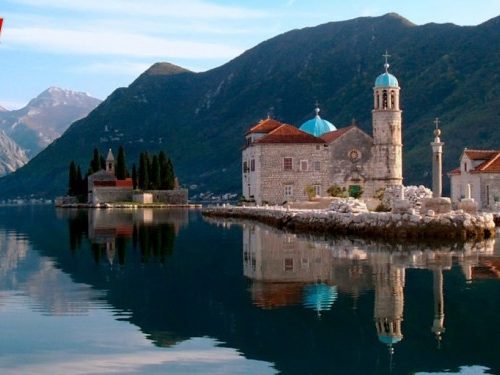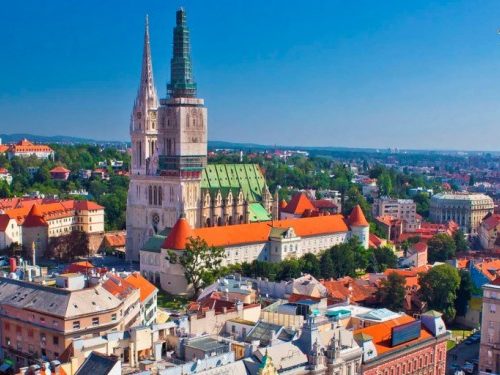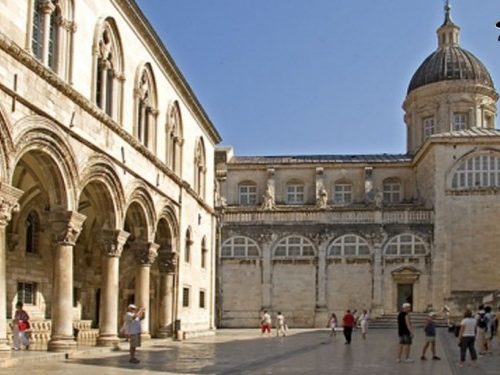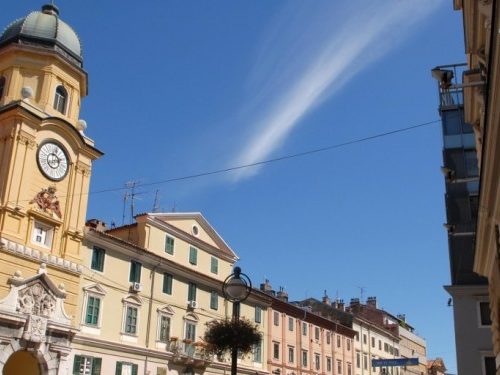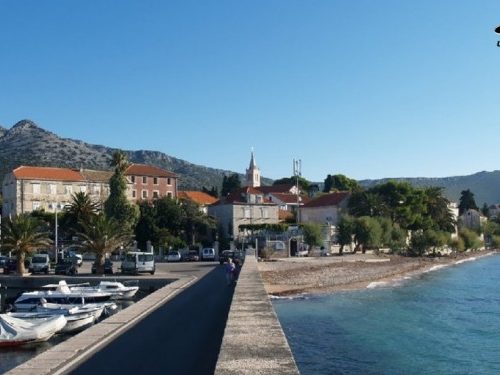Croatia officially the Republic of Croatia is a unitary democratic parliamentary republic at the crossroads of Central Europe, Balkans, and the Mediterranean. Its capital and largest city is Zagreb. The Croats arrived in the area of present-day Croatia during the early part of the 7th century. They organised the state into two duchies by the 9th century. Tomislav became the first king by 925 AD, elevating Croatia to the status of a kingdom. The Kingdom of Croatia retained its sovereignty for nearly two centuries, reaching its peak during the rule of Kings Peter Krešimir IV and Dmitar Zvonimir. Croatia entered a personal union with Hungary in 1102. In 1527, faced with Ottoman conquest the Croatian Parliament elected Ferdinand I of the House of Habsburg to the Croatian throne. In 1918, after World War I, Croatia was included in the unrecognized State of Slovenes, Croats, and Serbs which seceded from Austria–Hungary and merged into the Kingdom of Yugoslavia. Croatia today has a very high Human Development Index. The International Monetary Fund classified Croatia as an emerging and developing economy, and the World Bank identified it as a high income economy. Croatia is a member of the European Union, United Nations, the Council of Europe, NATO, the World Trade Organization and a founding member of the Union for the Mediterranean. The service sector dominates Croatia’s economy, followed by the industrial sector and agriculture. Tourism is a significant source of revenue during the summer, with Croatia ranked the 18th most popular tourist destination in the world. The state controls a part of the economy, with substantial government expenditure. The European Union is Croatia’s most important trading partner. Since 2000, the Croatian government has invested in infrastructure, especially transport routes and facilities along the Pan-European corridors. Internal sources produce a significant portion of energy in Croatia; the rest is imported.

Croatia
Prehistory and antiquity
The area known as Croatia today was inhabited throughout the prehistoric period. Fossils of Neanderthals dating to the middle Palaeolithic period have been unearthed in northern Croatia, with the most famous and the best presented site in Krapina. Remnants of several Neolithic and Chalcolithic cultures were found in all regions of the country.
Greek and Roman rule
Much later, the region was settled by Liburnians and Illyrians, while the first Greek colonies were established on the islands of Korčula, Hvar and Vis. In 9 AD the territory of today’s Croatia became part of the Roman Empire. Emperor Diocletian built a large palace in Split when he retired in AD 305.During the 5th century, one of the last Emperors of the Western Roman Empire, Julius Nepos, ruled his small empire from the palace. The period ends with Avar and Croat invasions in the first half of the 7th century and destruction of almost all Roman towns. Roman survivors retreated to more favourable sites on the coast, islands and mountains. The city of Dubrovnik was founded by such survivors from Epidaurum.
Middle Ages
According to the work De Administrando Imperio written by the 10th-century Byzantine EmperorConstantine VII, the Croats had arrived in what is today Croatia in the early 7th century, however that claim is disputed and competing hypotheses date the event between the 6th and the 9th centuries. Eventually two dukedoms were formed—Duchy of Pannonia and Duchy of Dalmatia, ruled by Ljudevit Posavski and Borna, as attested by chronicles of Einhard starting in 818. The Frankish overlordship ended during the reign of Mislav two decades later. According to the Constantine VII Christianization of Croats began in the 7th century, but the claim is disputed and generally Christianization is associated with the 9th century. Tomislav was the first ruler of Croatia who was styled a king in a letter from the Pope John X, dating kingdom of Croatia to year 925. For the next four centuries, the Kingdom of Croatia was ruled by the Sabor (parliament) and aBan (viceroy) appointed by the king. The period saw increasing threat of Ottoman conquest and struggle against the Republic of Venice for control of coastal areas. The Venetians gained control over most of Dalmatia by 1428, with exception of the city-state of Dubrovnik which became independent. Ottoman conquests led to the 1493 Battle of Krbava field and 1526 Battle of Mohács, both ending in decisive Ottoman victories.
Austria-Hungary (1538–1918)
Following the decisive Ottoman victories, Croatia was split into civilian and military territories, with the partition formed in 1538. The military territories would become known as the Croatian Military Frontier and were under direct Imperial control. Ottoman advances in the Croatian territory continued until the 1593 Battle of Sisak, the first decisive Ottoman defeat, and stabilisation of borders. During the Great Turkish War (1667–1698), Slavonia was regained but western Bosnia, which had been part of Croatia before the Ottoman conquest, remained outside Croatian control. The Ottoman wars instigated great demographic changes. Croats migrated towards Austria and the present-day Burgenland Croats are direct descendants of these settlers. Between 1797 and 1809 the First French Empire gradually occupied the entire eastern Adriaticcoastline and a substantial part of its hinterland, ending the Venetian and the Ragusan republics, establishing the Illyrian Provinces. In response the Royal Navy started the blockade of the Adriatic Sea leading to the Battle of Vis in 1811. The 1830s and 1840s saw romantic nationalism inspire the Croatian National Revival, a political and cultural campaign advocating the unity of all South Slavs in the empire. Its primary focus was the establishment of a standard language as a counterweight to Hungarian, along with the promotion of Croatian literature and culture. During the Hungarian Revolution of 1848 Croatia sided with the Austrians, Ban Josip Jelačić helping defeat the Hungarian forces in 1849, and ushering a period ofGermanization policy. By the 1860s, failure of the policy became apparent, leading to the Austro-Hungarian Compromise of 1867 and creation of a personal union between the crowns of the Austrian Empire and the Kingdom of Hungary. The treaty left the issue of Croatia’s status to Hungary, and the status was resolved by theCroatian–Hungarian Settlement of 1868, when kingdoms of Croatia and Slavonia were united. After Austria-Hungary occupied Bosnia and Herzegovina following the 1878 Treaty of Berlin, the Croatian Military Frontier was abolished and the territory returned to Croatia in 1881, pursuant to provisions of the Croatian-Hungarian settlement. Renewed efforts to reform Austria-Hungary, entailing federalisation with Croatia as a federal unit, were stopped by advent of World War I.
Yugoslavia (1918–1991)
On 29 October 1918 the Croatian Sabor declared independence and decided to join the newly formed State of Slovenes, Croats and Serbs,[29] which in turn entered into union with the Kingdom of Serbia on 4 December 1918 to form the Kingdom of Serbs, Croats, and Slovenes. The 1921 constitution defining the country as a unitary state and abolition of historical administrative divisions effectively ended Croatian autonomy. The new constitution was opposed by the most widely supported national political party—the Croatian Peasant Party (HSS) led by Stjepan Radić. The political situation deteriorated further as Radić was assassinated in the National Assembly in 1928, leading to the dictatorship of King Alexander in January 1929. The dictatorship formally ended in 1931 when the king imposed a more unitarian constitution, and changed the name of the country to Yugoslavia. In April 1941, Yugoslavia was occupied by Germany and Italy. Following the invasion the territory, parts of Croatia, Bosnia and Herzegovina, and the region of Syrmia were incorporated into theIndependent State of Croatia (NDH), a Nazi-backed puppet state. Parts of Dalmatia were annexed by Italy and the northern Croatian regions of Baranja and Međimurje were annexed by Hungary. After the World War II, Croatia became a single-party Socialist federal unit of the SFR Yugoslavia, ruled by the Communists, but enjoying a degree of autonomy within the federation. In 1967, Croatian authors and linguists published a Declaration on the Status and Name of the Croatian Standard Language demanding greater autonomy for Croatian language. In the 1980s the political situation in Yugoslavia deteriorated with national tension fanned by the 1986 Serbian SANU Memorandum and the 1989 coups in Vojvodina, Kosovo and Montenegro. In January 1990, the Communist Party fragmented along national lines, with the Croatian faction demanding a looser federation. In the same year, the first multi-party elections were held in Croatia, with Franjo Tuđman’s win raising nationalist tensions further. Serbs in Croatia left Sabor and declared the autonomy of areas that would soon become the unrecognised Republic of Serbian Krajina, intent on achieving independence from Croatia.
Independence
As tensions rose, Croatia declared independence in June 1991, however the declaration came into effect on 8 October 1991. In the meantime, tensions escalated into theCroatian War of Independence when the Yugoslav National Army and various Serbparamilitaries attacked Croatia. By the end of 1991, a high intensity war fought along a wide front reduced Croatia to control of about two-thirds of its territory. On 15 January 1992, Croatia gained diplomatic recognition by the European Economic Communitymembers, and subsequently the United Nations. The war effectively ended in 1995 with a decisive victory by Croatia in August 1995. The remaining occupied areas were restored to Croatia pursuant to the Erdut Agreement of November 1995, with the process concluded in January 1998. Croatia became a World Trade Organization (WTO) member on 30 November 2000. The country signed a Stabilization and Association Agreement (SAA) with the European Union in October 2001. Croatia joined NATO on 1 April 2009, and the European Union on 1 July 2013.
Traditional Food
- Pršut – is a dry-cured ham, an essential part of every type of celebration in Croatia and every restaurant menu. The best domestic pršut is made with a help of nature – fall and early winter are the weather conditions necessary for its making, and local bura wind (the cold, salty wind from the Adriatic) is what makes its texture and taste unique.
- Paški sir – is cheese from Pag Island and it’s made entirely from milk produced by sheep grazing freely local sparse grass, various herbs and aromatic plants. The result of all this is its special flavor which has been recognized globally and awarded year after year.
- Ispod peke – is actually a term describing a method of food preparation and it’s really famous throughout Croatia. When someone says he/she is preparing something ispod peke, it means you’re up for a real treat.
- Pašticada – is a traditional meat dish from Dalmatia. Beef is the main ingredient and, before the actual cooking which lasts a few hours takes place, it’s marinated for 24 hours in red wine, garlic and various herbs such as rosemary and sage.
- Crni rižot – or black risotto, is another Dalmatian must-try dish. It’s a seafood risotto with cuttlefish and squid as main ingredients. It’s name and black color are result of squids’ ink which gives this delicacy its distinctive Mediterranean flavor and personality.
- Riba na gradele i blitva – this is traditionally the most common combination in Dalmatia: mixed grilled fish paired with chard boiled with potatoes. Fresh fish prepared on gradele (i.e. grilled on woodfire), seasoned with garlic, parsley and olive oil, is something you’ll see locals preparing all along the coast.
- Brudet – is a fish stew traditionally made in Istria and Dalmatia. It’s made of several types of fish, put in layers in a single pot and cooked in tomato sauce. You’re not allowed to stir the ingredients but only shake the pot from time to time.
- Tartufi – these rare and highly values mushrooms, believed to have aphrodisiac powers, are typical for Istria region. They grow underground and only specially trained dogs can locate them.
- Fuži i pljukanci – are yet another dish traditional for Istria. Actually it’s a homemade pasta which comes in various sorts, of which fuži and pljukanci are the most famous ones. They are completely handmade and hand-rolled.
- Janjetina s ražnja – or lamb on the spit, is the most popular method of preparing lamb in Croatia. Throughout the coast you’ll see signs directing you to places which serve janjetina s ražnja. The whole lamb is rotated slowly above hot coals, resulting in succulent roast meat no one can resist.
Traditional drinks
- Badel – Badel is the best known brand of traditional Crotian rakija. According to its traditional recipe from 1862 it is made from specially selected local wine distillates which have to mature in oak barrels a couple of years.
- Beer – Beer is a very popular drink in Croatia. There are several breweries throughout the country, with two major producers, Karlovačka Pivovara and Zagrebačka Pivovara.
- Coffee – Croatia is a coffee drinkers’ nation with the average annual consumption of 5 kg per person. The popularity of coffee has its roots in the country’s stormy past, with both the Habsburg and Ottoman Empires fighting for dominance.
- Graševina – Graševina is an ancient grape variety, grown throughout Central Europe, that is used to produce fresh and fruity white wines. Its origins remain unclear, however it is believed to be brought to Central Europe by the Romans.
- Kruškovac – This sweet alcoholic liqueur is made from pears, according to a very old recipe. It is one of the most popular maraska liqueurs abroad.
- Malvazia – This delicious fortified wine has a very long history. Its origins date back to the 1st century BC and it was probably the Greeks who first introduced this drink. Its popularity grew significantly during the Arab domination of Sicily.
- Maraska – Maraschino is one of only a few liqueurs in the world produced in the process of distillation. Its name comes from the characteristic bitter-sweet taste of the Marasca cherry.
- Mead – Originally called gvirc, mead is the tradional drink of Slavs. It was first made by members of the nomadic Slavic tribes which made drinking it a part of the pagan cult of Perun.
- Archaeological Museum Osijek
- Archaeological Museum,
- Art Pavilion in Zagreb
- Međimurje County Museum
- Croatian Museum of Naïve Art
- Center “Milutin Milanković”
- Eltz Manor
- Gallery of Fine Arts, Osijek
- Gallery of Fine Arts, Split
- Gallery Vernissage
- Gallery Waldinger
- Glyptotheque
- Ivan Meštrović Gallery
- Klovićevi dvori
- Lauba
- Marton Museum
- Meštrović Pavilion
- Mimara Museum
- Modern Gallery,
- Museum Broken Relationships
- Archaeological Monuments
- Museum of Contemporary Art
- Museum of Slavonia
- Oršić Castle in Gornja Stubica
- Ozalj Castle
- Pejačević Castle
- Gallery of Old Masters
- Technical Museum
- Trakošćan Castle
- Veliki Tabor Castle
Aquae Iasae
Aquae Iasae was the Roman settlement and Roman bath in the area of present cityVaraždinske Toplice, Croatia. Today it is the name of the archaeological site.
Arch of the Sergii
Arch of the Sergii is an Ancient Roman triumphal arch located in Pula, Croatia. The arch commemorates three brothers of the Sergii family, specifically Lucius Sergius Lepidus, a tribune serving in the twenty-ninth legion that participated in the Battle of Actium and disbanded in 27 BC.
Bilina
Bilina is a historic late-medieval site in the Bukovica region, westwards from the town of Knin, southern Croatia.The site is known as the seat of the Drašković noble family in the 15th century and in the beginning of the 16th century. Bartol (English:Bartholomew) Drašković, the head of the family, had an estate with the castle there. His wife Ana Drašković née Utješinović, a sister of the Catholic cardinal Juraj Utješinović (George Utissenich alias George Martinuzzi), bore him on February 5th, 1525, the firstborn sonJuraj (English: George), a famous Croatian Catholic Bishop, Cardinal and statesman, who was the Ban (Viceroy) of Croatia between 1567 and 1578.
Bribir
Bribir is a village in Šibenik-Knin County, near the town of Skradin, southern Croatia. It has 105 inhabitants (2011 census) and its post code is HR-22223. The village is located at the foot of the hill of Bribir (Croatian: Bribirska glavica), which is an archaeological site.Bribir was founded in ancient Illyrian times and evolved into Varvaria, a Roman municipium.The Catholic cardinal Juraj Utješinović (George Utissenich alias George Martinuzzi), bore him on February 5th, 1525, the firstborn sonJuraj (English: George), a famous Croatian Catholic Bishop, Cardinal and statesman, who was the Ban (Viceroy) of Croatia between 1567 and 1578.
Burnum
Burnum an archaeological site, was a RomanLegion camp and town. It is located 2.5 km north of Kistanje, in inland Dalmatia,Croatia. The remains include a praetorium, the foundations of several rooms, the amphitheatre and the aqueduct.
The Cathedral of Saint Domnius
The Cathedral of Saint Domnius (Croatian: Katedrala Svetog Duje), known locally as the Saint Dujam (Sveti Dujam) or colloquially Saint Duje (Sveti Duje), is theCatholic cathedral in Split, Croatia. The cathedral is the seat of the Archdiocese of Split-Makarska, headed by Archbishop Marin Barišić.
Cetina
Cetina is a river in southern Croatia. It has a length of 101 km (63 mi) and its basin covers an area of 1,463 km2 (565 sq mi). Cetina descends from an altitude of 385 m at its source to the sea level when it flows into the Adriatic Sea. It is the most water-rich river in Dalmatia.
Church of St. Donatus
The Church of St. Donatus is a church located in Zadar, Croatia. Its name refers toDonatus of Zadar, who began construction on this church in the 9th century and ended it on the northeastern part of the Roman forum. Originally named (and dedicated to) thechurch of the Holy Trinity, in the 15th century it was renamed the Church of St. Donatus.
Hollow Church
Hollow Church is a name given to a part of the archeological excavations of what used to be a Croatian romanesque Roman Catholic church in the 11th century. Originally named Basillica of Saint Peter and Moses, the building was built on the foundations of an older Christian church next to a 6th-century Byzantinechapel in the vicinity of the ancient ruins of Salona.
Narona
Narona was the name of the ancient Roman city that was located in the Neretva valley in present day Croatia. It was part of theRoman province of Dalmatia. The city was established after the Illyrian Wars and was located on the alluvial plains, between present day city of Metković and village of Vid. It was founded as a Hellenistic emporium in c. 3rd/2nd century BC, first time mentioned in the chapter 24 of the Periplus of Pseudo-Scylax. Narona became the major Roman stronghold in the 1st century BC. In the 6th century AD, it came under Byzantine rule. The settlement ceased to be in 7th century after the arrival of Slavic tribes in the region.
Otišić
Otišić is a small village in the Split-Dalmatia County, Croatia.Located in inland Dalmatia, south of Vrlika, on the State route D1 between towns of Sinjand Vrlika. Otišić is a settlement in the Vrlika municipality, and has a population of about 20. Before war (1991–1995) Otišić had population about 1000. The majority of the population were Serbs.
Peruča
Lake Peruća or Peruča is the secondartificial lake in Croatia after Lake Dubrava. It is located in the Split-Dalmatia county.Located in inland Dalmatia, south of the source of the River Cetina, northeast of the State route D1 between the towns of Sinj and Vrlika.The Lake is on the course of the River Cetina, bounded by Svilaja mountain to the southwest and Dinara mountain to the northeast.
Smrdelje
Smrdelje is a small village located 8 km southwest of Kistanje, in the continental part of Šibenik-Knin County, Croatia.The broader area of the village comprises several prehistoric tumuli. The remains ofRoman architecture are found on two localities, as well as several graves from the early Croatian period.
The Temple of Augustus
The Temple of Augustus is a well-preserved Roman temple in the city of Pula, Croatia (known in Roman times as Pola). Dedicated to the first Roman emperor, Augustus, it was probably built during the emperor’s lifetime at some point between 2 BC and his death in AD 14. It was built on a podium with atetrastyle prostyle porch of Corinthian columns and measures about 8 m (26 ft) by 17.3 m (57 ft). The richly decorated frieze is similar to that of a somewhat larger and older temple, the Maison Carrée in Nîmes, France.
Brijuni
The Brijuni or the Brijuni Islands (also known as the Brionian Islands; Italian: Brioni) are a group of fourteen small islands in the Croatian part of the northern Adriatic Sea, separated from the west coast of the Istrian peninsula by the narrow Fažana Strait. The largest island, Veliki Brijun Island (also known as Brioni Grande or Veli Brijun), (5.6 km2), lies 2 kilometres (1 mile) off the coast.
Kornati
The Kornati archipelago of Croatia, also known as the Stomorski islands, is located in the northern part of Dalmatia, south from Zadar and west fromŠibenik, in the Šibenik-Knin county. With 35 kilometres (22 miles) length and 140islands, some large, some small, in a sea area of about 320 square kilometres (124 sq mi), the Kornati are the densest archipelago in the Mediterranean Sea.
Krka
Krka National Park is one of the Croatian national parks, named after the river Krka that it encloses. It is located along the middle-lower course of the Krka River in central Dalmatia, in Šibenik-Knin county, downstream Miljevci area, and just a few kilometers northeast of the city of Šibenik.
Paklenica
The Paklenica karst river canyon is a national park in Croatia. It is located in Starigrad, northern Dalmatia, at the southern slopes of Velebit mountain, not far from Zadar. It has two canyons: Mala (Small) and Velika (Big) Paklenica. Today there is no water flowing throughout Mala Paklenica. Near the entrance into the Velika Paklenica there is an artificial basement/cave complex that had been built for Josip Broz Tito during the tension between Yugoslavia and the USSR in the late 1940s and early 1950s.
Plitvice Lakes
Plitvice Lakes National Park is the oldest national park in Southeast Europe and the largest national park in Croatia.The national park was founded in 1949 and is situated in the mountainous karst area of central Croatia, at the border to Bosnia and Herzegovina. The important north-south road connection, which passes through the national park area, connects the Croatian inland with the Adriatic coastal region.
Sjeverni Velebit
Sjeverni Velebit is a national park in Croatia that covers 109 km² of the northern section of the Velebit mountain, the largest mountain in Croatia. Because of the abundant variety of this part of the Velebit range and its authenticity, the area was upgraded from its classification as a nature reserve to a national park in 1999, and started work in September the same year.
Štirovača
Štirovača is a forest in North Velebit.Reserve the forest vegetation. Its area is 118.5 acres. Most extends to an altitude of 1100 metres.Stirovaca the rain forest of beech and spruce. Most of it is a rainforest in the secondary stage Klepina duliba. The end was once more covered with forest, and today, of all the towering forests remained a small part in Štirovača.

